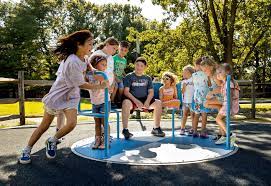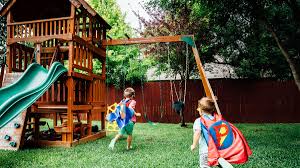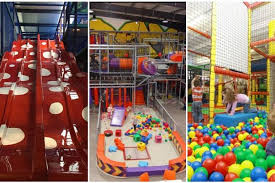
Embracing Diversity: Creating an Inclusive Play Area for All Children
Title: Creating an Inclusive Play Area: Where Everyone Can Play and Thrive
Introduction:
Playgrounds are not just spaces for fun and games; they are essential for children’s physical, social, and cognitive development. However, it is crucial to ensure that these spaces are inclusive, welcoming children of all abilities. Inclusive play areas go beyond physical accessibility, focusing on creating an environment where every child can fully participate and thrive. Let’s explore the importance of inclusive play areas and how they benefit children of diverse backgrounds.
Promoting Physical Accessibility:
An inclusive play area begins with ensuring physical accessibility for children with mobility challenges. This means providing ramps, wide pathways, and accessible equipment that allows children using wheelchairs or walking aids to navigate freely. Additionally, offering ground-level play features allows children with limited mobility to engage actively without barriers.
Encouraging Sensory Exploration:
Children experience the world through their senses, making sensory-rich play areas essential for their development. Inclusive play spaces should include a variety of tactile surfaces, auditory elements like musical instruments or sound walls, and visually stimulating features such as vibrant colours or textured panels. By catering to different sensory needs, these areas create opportunities for all children to engage and explore in their unique ways.
Fostering Social Interaction:
Inclusive play areas provide a platform for children from diverse backgrounds to interact and build meaningful connections. Designing spaces that encourage cooperative play helps foster empathy, understanding, and acceptance among children. Incorporating inclusive seating arrangements within the play area promotes social interaction between parents or caregivers as well.
Adaptable Equipment and Activities:
Flexibility is key when designing an inclusive play area. Including adaptable equipment that can be adjusted based on individual needs ensures that every child can actively participate in various activities. For instance, swings with harnesses or supportive seats allow children with physical disabilities to enjoy swinging alongside their peers. Offering a mix of active and quiet activities caters to different energy levels and play preferences.
Educational Signage and Visual Supports:
Inclusive play areas can benefit from clear signage that uses symbols, pictures, or simple instructions to aid children with communication difficulties. Visual supports like visual schedules or social stories can help children with autism or other cognitive challenges understand the play area rules and expectations. These supports create a more inclusive environment where all children can engage confidently.
Training Staff and Promoting Inclusion:
To ensure the success of an inclusive play area, it is essential to train staff on inclusivity, diversity, and disability awareness. Staff members should be knowledgeable about assisting children with different needs, promoting positive interactions, and addressing any concerns promptly. Regular communication with parents and caregivers helps create a collaborative approach towards supporting each child’s unique requirements.
Conclusion:
Inclusive play areas hold immense value in providing opportunities for all children to engage in play, learn from one another, and develop important life skills. By designing spaces that are physically accessible, sensory-rich, socially interactive, and adaptable to individual needs, we create an environment where every child feels welcome and included. Let’s continue to advocate for inclusive play areas so that every child can experience the joy of play without limitations or barriers.
Creating an Inclusive Play Area: 7 Essential Tips for Accessibility and Enjoyment
- Ensure the play area is accessible for all, including those with physical disabilities and sensory impairments.
- Provide a range of activities suitable for different age groups and abilities.
- Include seating areas where people can rest or watch others play.
- Make sure the play area is well lit and secure to ensure safety for everyone who uses it.
- Consider using natural materials such as wood, sand and water in your design to create an interesting environment that encourages exploration and discovery.
- Install signage that clearly states the rules of use so everyone knows how to behave safely in the play area.
- Regularly inspect equipment, surfaces and fences to make sure they are safe for use by all users at all times
Ensure the play area is accessible for all, including those with physical disabilities and sensory impairments.
Title: Ensuring Accessibility: Key to an Inclusive Play Area
Introduction:
Creating an inclusive play area is not just about providing a space for children to have fun; it’s about ensuring that every child, regardless of their abilities, can fully participate and enjoy the experience. One crucial tip for achieving inclusivity is to make sure the play area is accessible for all, including those with physical disabilities and sensory impairments. By removing barriers and considering diverse needs, we can create a truly inclusive environment where every child can thrive.
Physical Accessibility:
Physical accessibility is a fundamental aspect of an inclusive play area. It involves providing ramps or gently sloping pathways to allow easy access for children using wheelchairs or walking aids. Wide entrances and clear pathways ensure that everyone can move around freely without obstacles. Additionally, having ground-level play features allows children with mobility challenges to engage actively alongside their peers.
Sensory Considerations:
Sensory impairments should also be taken into account when designing an inclusive play area. By incorporating elements that cater to different sensory needs, we create a more engaging experience for all children. This may include using contrasting colors or textures on surfaces, incorporating tactile panels or surfaces for tactile exploration, and including auditory elements like musical instruments or sound walls. These additions help stimulate the senses and make the play area more enjoyable and accessible to children with sensory impairments.
Safety Measures:
Ensuring safety within an inclusive play area is paramount. Clear signage with symbols or pictures can assist children with communication difficulties in understanding rules and guidelines. Safety measures such as cushioned flooring or padding around equipment help prevent injuries and provide a safer environment for all children, including those with physical disabilities who may have limited balance or coordination.
Inclusive Equipment:
Choosing inclusive equipment is another essential aspect of creating an accessible play area. Consider installing swings with harnesses or supportive seats that accommodate children with physical disabilities. Providing a range of equipment options ensures that children of all abilities can engage in play activities that suit their needs and preferences. Adaptable equipment that can be adjusted or modified based on individual requirements is also beneficial for creating an inclusive environment.
Consulting Experts:
When designing an inclusive play area, it can be helpful to consult with experts in the field of accessibility and inclusion. They can provide valuable insights and guidance on how to create a space that caters to diverse needs. Engaging with disability organizations, occupational therapists, or accessibility consultants can help ensure that the play area meets the necessary standards and guidelines for inclusivity.
Conclusion:
Ensuring accessibility for all is a crucial tip when creating an inclusive play area. By removing physical barriers, considering sensory needs, implementing safety measures, providing inclusive equipment, and seeking expert advice, we can create a space where every child feels welcome and included. Let’s strive to design play areas that celebrate diversity and enable every child to enjoy the benefits of play, fostering a sense of belonging and joy for all.
Provide a range of activities suitable for different age groups and abilities.
Title: Inclusive Play Areas: Catering to All Ages and Abilities
Introduction:
When it comes to creating inclusive play areas, one crucial tip is to provide a range of activities suitable for different age groups and abilities. By offering a variety of play options, we can ensure that every child, regardless of their age or ability, can find something engaging and enjoyable. Let’s explore why this tip is essential for fostering inclusivity in play areas.
Catering to Diverse Age Groups:
Children of different ages have varying interests, physical abilities, and cognitive skills. Designing an inclusive play area means considering the needs and preferences of children across various age groups. From toddler-friendly play structures with low platforms and gentle slides to more challenging equipment for older children, providing a range of options ensures that everyone can find age-appropriate activities that match their developmental stage.
Promoting Skill Development:
Inclusive play areas should offer activities that cater to different abilities and skill levels. By incorporating both physically challenging equipment and more accessible features, children with varying physical abilities can engage in play that suits their capabilities. This promotes skill development, confidence building, and a sense of achievement for all children.
Encouraging Cooperative Play:
An inclusive play area should foster social interaction among children of different ages and abilities. Including activities that encourage cooperative play allows children to learn from one another, develop empathy, and build friendships across diverse backgrounds. Features like interactive games or team-oriented challenges promote collaboration while ensuring that every child can participate at their own level.
Providing Sensory Stimulation:
Sensory experiences are integral to inclusive play areas. Incorporating activities that appeal to different senses benefits children with varying sensory needs or sensitivities. For instance, tactile elements like sand or water play tables engage the sense of touch while musical instruments or sound walls stimulate auditory senses. By offering a variety of sensory-rich activities, we create an inclusive environment where all children can explore the world through their senses.
Considering Accessibility:
When designing activities for different abilities, it is crucial to ensure that they are accessible to all children. This may involve providing inclusive seating options, ensuring pathways are wide enough for wheelchair access, or incorporating equipment with adjustable features. By considering accessibility in the design process, we create an environment where every child can participate fully and independently.
Conclusion:
Providing a range of activities suitable for different age groups and abilities is a vital aspect of creating inclusive play areas. By catering to diverse needs and interests, we ensure that every child has the opportunity to engage in play that is both enjoyable and developmentally appropriate. Let’s continue to design inclusive play areas that celebrate diversity, promote inclusivity, and create memorable experiences for children of all ages and abilities.
Include seating areas where people can rest or watch others play.
Title: Creating Inclusive Play Areas: The Importance of Rest and Observation
Introduction:
When designing inclusive play areas, it’s crucial to consider the needs of not only the children actively engaged in play but also those who may require a moment to rest or observe. Including seating areas within play spaces is an essential aspect of promoting inclusivity and ensuring that everyone can enjoy the experience fully. Let’s explore why seating areas are important and how they contribute to creating a welcoming environment for all.
Promoting Rest and Recharge:
Play can be exhilarating, but it also requires energy and physical exertion. By incorporating seating areas within the play area, children and adults alike have a designated space where they can take a break, catch their breath, or recharge their energy levels. This provision ensures that individuals with different stamina levels or varying abilities can participate comfortably without feeling overwhelmed.
Encouraging Social Interaction:
Seating areas in inclusive play spaces offer more than just rest; they provide opportunities for social interaction among parents, caregivers, and children. These designated spots become gathering points where conversations can flourish, relationships can be formed, and community bonds can strengthen. Observing others at play also fosters inclusion by encouraging empathy and understanding among all visitors.
Creating an Inclusive Environment:
Inclusive play areas aim to cater to diverse needs, including those who may not actively engage in physical play due to various reasons such as age or physical limitations. Seating areas allow individuals who prefer not to participate directly in activities to still feel connected and involved within the vibrant atmosphere of the play area. They provide a space where everyone feels welcome and valued regardless of their level of participation.
Supporting Caregivers:
Seating areas are not only beneficial for children but also for parents, grandparents, or guardians accompanying them. Caregivers often need a place where they can keep an eye on their children while taking a moment to relax themselves. Including comfortable seating options allows caregivers to watch over their children’s play, ensuring their safety and providing peace of mind.
Encouraging Inclusive Design:
Seating areas should be designed with inclusivity in mind. They should be easily accessible, providing ample space for individuals using mobility aids such as wheelchairs or prams. Incorporating shaded areas or covering canopies ensures that seating is pleasant even during hot weather or light rain, accommodating visitors’ diverse needs throughout the year.
Conclusion:
Inclusive play areas are about more than just physical activities; they are spaces where everyone can feel included and valued. By incorporating seating areas within these spaces, we create an environment that promotes rest, social interaction, and a sense of belonging for all visitors. Let’s continue to prioritize inclusive design by including seating options that cater to diverse needs, ensuring that everyone can enjoy the joys of play and create lasting memories together.
Make sure the play area is well lit and secure to ensure safety for everyone who uses it.
Title: Ensuring Safety in Inclusive Play Areas: The Importance of Adequate Lighting and Security
Introduction:
When designing inclusive play areas, it is crucial to prioritize the safety and well-being of all children. One essential aspect often overlooked is the importance of proper lighting and security measures. By ensuring that the play area is well lit and secure, we create an environment where children can play freely, caregivers can have peace of mind, and everyone can enjoy their time to the fullest.
Illuminating the Way:
Adequate lighting plays a significant role in creating a safe and inclusive play area. Ample lighting ensures that children can navigate the space confidently, reducing the risk of accidents or injuries. Well-lit pathways, activity areas, and equipment allow children with visual impairments or sensory sensitivities to engage fully in play without any hindrances. Additionally, proper lighting also enhances supervision by allowing caregivers to keep a close eye on their children’s activities.
Enhancing Security Measures:
Security measures are essential for maintaining a safe environment within inclusive play areas. Fencing around the perimeter helps prevent unauthorized access and provides a clear boundary for parents or caregivers to keep track of their children’s whereabouts. Secure entrances with child-friendly locks further enhance safety by minimizing the risk of children wandering off unattended.
Surveillance systems or CCTV cameras strategically placed within the play area act as an additional layer of security. These measures not only deter potential incidents but also provide valuable footage for identifying any safety concerns promptly. Regular maintenance checks should be conducted to ensure that all security features are functioning correctly.
Consideration for Nighttime Use:
Inclusive play areas should be designed with consideration for nighttime use as well. Adequate lighting during evening hours extends the opportunities for children to engage in outdoor activities even after daylight fades away. Well-placed lights not only ensure visibility but also create a welcoming atmosphere that encourages families to enjoy quality time together even after sunset.
Community Engagement:
Creating a safe and secure inclusive play area requires the collaboration of the community. Engaging with parents, caregivers, and local authorities can help identify potential safety concerns and implement necessary improvements. Regular communication channels should be established to address any issues promptly and ensure ongoing maintenance of lighting and security systems.
Conclusion:
Inclusive play areas should prioritize safety as a fundamental aspect of their design. Adequate lighting and security measures are vital components in creating an environment where children can play freely, caregivers can relax, and everyone feels secure. By illuminating the play area effectively, implementing appropriate security features, and engaging with the community, we can ensure that inclusive play spaces are safe havens for children of all abilities to thrive, explore, and create lasting memories.
Consider using natural materials such as wood, sand and water in your design to create an interesting environment that encourages exploration and discovery.
Inclusive Play Areas: Embracing Nature’s Elements for Exploration and Discovery
When it comes to designing an inclusive play area, one important tip to consider is incorporating natural materials into the design. By using materials such as wood, sand, and water, we can create a captivating environment that encourages exploration, discovery, and endless possibilities for children of all abilities.
Natural materials offer a multitude of benefits in an inclusive play area. Firstly, they provide a sensory-rich experience that engages children’s senses in unique ways. The texture of wood invites tactile exploration, while the feel of sand running through fingers stimulates the sense of touch. Water adds an element of surprise and excitement as children interact with its flowing nature. These experiences are not only enjoyable but also promote cognitive development and sensory integration.
Furthermore, natural materials create a visually appealing environment that sparks curiosity and imagination. The organic shapes and textures found in wood, sand, and water evoke a sense of wonder and encourage children to explore their surroundings. They can become anything from a pirate ship sailing on the sea of sand to a bridge crossing over a babbling brook. Natural elements provide endless opportunities for imaginative play.
Inclusive play areas should also prioritize accessibility for children with diverse abilities. Natural materials lend themselves well to this goal. Wood can be shaped into ramps or platforms that allow easy access for children using mobility aids such as wheelchairs or walkers. Sand can be levelled out to create smooth surfaces for easy navigation. Water features can have varying depths or adjustable flow rates to accommodate different levels of mobility.
Moreover, the use of natural materials aligns with environmental sustainability principles. By incorporating wood sourced from responsibly managed forests or using recycled materials where possible, we teach children about the importance of caring for our planet while providing them with an eco-friendly play space.
In conclusion, embracing natural materials like wood, sand, and water in the design of inclusive play areas creates an environment that fosters exploration, discovery, and inclusivity. It engages children’s senses, stimulates their imagination, and promotes accessibility for all. Let us embrace the beauty of nature in our play spaces, allowing children to connect with the world around them while enjoying the benefits of inclusive play.
Install signage that clearly states the rules of use so everyone knows how to behave safely in the play area.
Title: Clear Signage: Promoting Safety and Inclusion in Play Areas
Introduction:
Inclusive play areas are designed to provide a safe and welcoming environment for children of all abilities. One crucial aspect of ensuring a safe and inclusive space is the installation of clear signage that clearly states the rules of use. By doing so, we not only promote safety but also foster an atmosphere where everyone understands how to behave respectfully and inclusively towards others.
Promoting Safety:
Safety is paramount in any play area, and clear signage plays a vital role in communicating important rules to children, parents, and caregivers. By prominently displaying signs that outline safety guidelines such as age-appropriate equipment usage, proper supervision requirements, and potential hazards to be aware of, we create an environment where everyone can enjoy playtime without unnecessary risks.
Facilitating Understanding:
Inclusive play areas welcome children from diverse backgrounds with varying abilities. Signage that clearly states the rules of use helps ensure that everyone understands how to interact with the equipment and each other respectfully. This includes guidelines on taking turns, sharing equipment, using inclusive language, and being mindful of personal space. When all users have a clear understanding of these expectations, it promotes positive social interactions and reduces the likelihood of conflicts or misunderstandings.
Supporting Independence:
Clear signage empowers children to take responsibility for their actions within the play area. When rules are clearly communicated through visual cues or simple instructions, children can understand what is expected from them independently. This fosters a sense of autonomy while promoting self-regulation skills as they navigate the play area safely and considerately.
Enhancing Inclusivity:
Inclusive play areas strive to create an environment where every child feels welcome and valued. By installing signage that uses inclusive language and symbols, we ensure that all users can comprehend the rules regardless of their communication abilities or language proficiency. Including visual supports like pictograms or simple illustrations alongside written instructions further aids understanding for children who may have difficulty reading or comprehending written text.
Promoting Community Responsibility:
Clear signage not only benefits the children but also encourages parents, caregivers, and other visitors to actively participate in creating a safe and inclusive play environment. By clearly stating the rules of use, we emphasize that safety and inclusivity are collective responsibilities. This fosters a sense of community ownership and encourages adults to model positive behavior, reinforcing the importance of following the guidelines for everyone’s benefit.
Conclusion:
Installing clear signage that outlines the rules of use in an inclusive play area is a fundamental step towards promoting safety and fostering an inclusive environment. By effectively communicating expectations, we empower children to navigate the space independently while encouraging positive social interactions. Let’s continue to prioritize clear signage as an essential component of creating inclusive play areas where everyone can enjoy themselves safely and feel included in the joy of play.
Regularly inspect equipment, surfaces and fences to make sure they are safe for use by all users at all times
Title: Ensuring Safety and Inclusion: Regular Inspections for Inclusive Play Areas
Introduction:
Creating an inclusive play area goes beyond just designing accessible features; it also involves ensuring the safety of all users. Regular inspections of equipment, surfaces, and fences are crucial to maintaining a safe environment where children of all abilities can play freely. Let’s delve into the importance of these inspections and how they contribute to an inclusive play area.
Safety First:
The safety of children should always be a top priority in any play area. Regular inspections help identify potential hazards or wear and tear that may compromise the safety of the equipment, surfaces, or fences. By addressing these issues promptly, we can prevent accidents and ensure that children can enjoy their playtime without unnecessary risks.
Inclusive Accessibility:
When conducting inspections, it is essential to consider the needs of all users, including those with disabilities or sensory sensitivities. Check for any barriers that may hinder accessibility, such as uneven surfaces or broken ramps. Ensure that handrails are secure and at an appropriate height for children of different abilities to use comfortably. By maintaining accessible features in good condition, we ensure that every child can fully participate in the play area.
Regular Maintenance:
Regular inspections allow for timely maintenance, preventing minor issues from escalating into major problems. Check for loose bolts or screws on equipment, worn-out surfacing materials, or damaged fences that may pose risks to children’s safety. Repairing or replacing these elements promptly ensures a safe environment for all users.
Quality Assurance:
By conducting regular inspections, you demonstrate your commitment to providing a high-quality play experience for all children. It shows parents/caregivers that you prioritize their child’s safety and well-being while using the play area. This builds trust and confidence in your establishment as a reliable inclusive space.
Collaboration with Experts:
If you lack expertise in conducting thorough inspections yourself, consider collaborating with professionals who specialize in playground safety assessments. These experts can provide comprehensive inspections, identify potential safety concerns, and offer recommendations for improvements. Their knowledge and experience can contribute significantly to maintaining a safe and inclusive play area.
Conclusion:
Regular inspections of equipment, surfaces, and fences are vital in creating an inclusive play area that is safe for all users. By proactively identifying and addressing potential hazards, we ensure that children of all abilities can play freely without compromising their well-being. Let’s commit to regular maintenance and collaborate with experts when needed to create a secure and inclusive environment where every child can explore, learn, and have fun safely.



